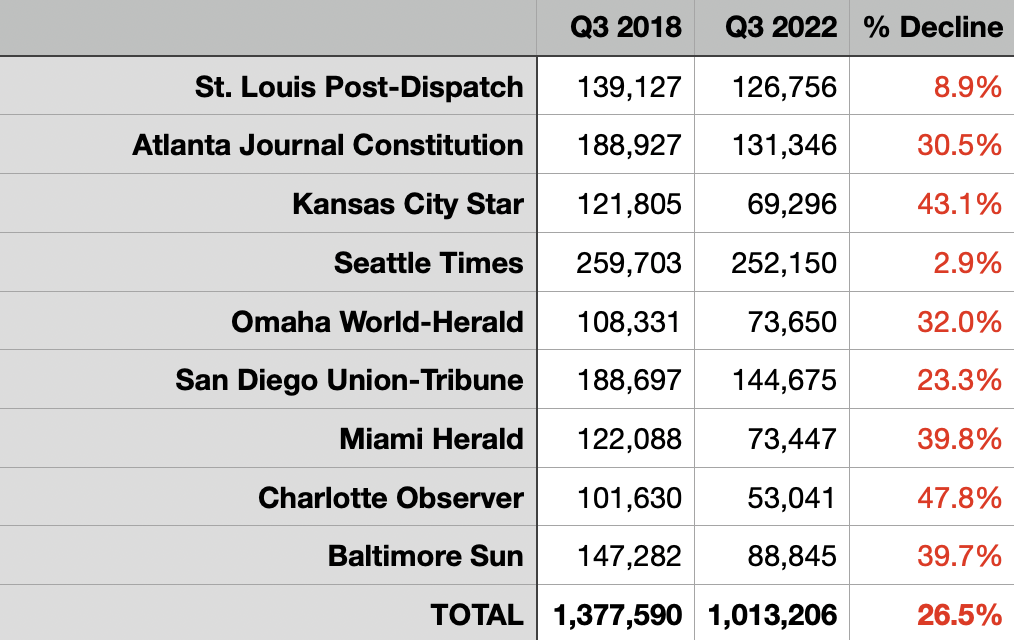Those certified ghouls and fools at GANNETT are destroying local news. I grew up reading a GANNETT newspaper in South Jersey (Courier Post, and it was mediocre, but they occasionally did worthy work. My mentor Nat Caldwell in Nashville told me that we would rue the day when GANNETT took over his beloved Tennesseean. He was right,
From Nieman Lab:
The scale of local news destruction in Gannett’s markets is astonishing
Gannett, America’s largest newspaper chain, should wake up each morning thankful for the existence of No. 2 Alden Global Capital.
After all, who could ask for a better point of comparison? Alden is the perfect industry villain, a faceless private equity fund dedicated to nothing but cost-cutting and cashflow-draining. Its corporate website contains a total of 21 words, nine of which are “Alden,” “Global,” or “Capital.” It’s run by a secretive billionaire who last gave an interview in the 1980s — the sort of person who can own 15 mansions in Palm Beach and still think: I could really use a 16th.It’s the type of company that inspires debates over whether “vulturous” is too kind of an adjective. If you’re writing an Atlantic cover story on “Who Killed America’s Newspapers?” Alden Global Capital will hand you the murder weapon, already dusted for prints.
Gannett, meanwhile, is at least a newspaper company, one more than a century old. It’s rarely been considered a particularly good one, mind you — its reputation for cheapness and cookie-cutter products go back decades. (As The New York Times described it in 1986: “a chain of mostly small and undistinguished, though highly profitable, newspapers.”) But it was at least a familiar name, run by news people and with at least some dedication to its civil role in hundreds of communities.
When Alden attempted a hostile takeover in 2019, anyone who cared about local news was put in the unfamiliar position of rooting for Gannett. Heck, if you squinted hard enough, Gannett could almost feel like the good guy. (If only because people like to believe there is a good guy in their industry, somewhere or another.)But “we’re better than Alden!” has its limits as a brand promise, and Gannett’s most recent annual report drives home the fact that no company has done more to shrink local journalism than it has in recent years. Let’s total up the damage — in raw numbers, if not in stories unbroken and facts not uncovered.
Vaporizing a newspaper chain in four years
While Alden failed in its bid for Gannett in 2019, it sparked a wave of newspaper industry consolidation that some had foreseen for years. Within a few months, the two largest newspaper companies in the United States — No. 1 Gannett and No. 2 GateHouse — announced they were merging. The name would remain Gannett, but GateHouse execs were mostly left in charge.At the end of 2018 — the last full pre-merger year — the two companies had roughly 24,338 employees in the United States and 27,600 worldwide. (Gannett also owns a small group of newspapers in the U.K.) The merger closed in mid-November 2019, by which time it had about 25,000worldwide and was diving headlong into a hunt for “inefficiencies.”
By December 31, 2019, the combined company was down to 21,255employees in the U.S. By the end of 2020, that had dropped to 18,141. A year later: 13,800. And its most recent SEC filing reports that, as of the end of 2022, Gannett had just 11,200 U.S. employees remaining (plus another roughly 3,000 overseas).
In other words, Gannett has eliminated more than half of its jobs in the United States in four years. It’s as if, instead of merging America’s two largest newspaper chains, one of them was simply wiped off the face of the earth.
That’s a cut substantially deeper than the rate of newspaper revenue decline. Why? Well, one reason is that to get the merger done, Gannett had to take out a giant loan at high interest rates, meaning hundreds of millions in revenues have had to be redirected to debt payments. To put it in perspective: In Q4 2022, digital subscriptions at Gannett newspapers — all of them — brought in a total of $35.5 million. But the company spent more than that, $47.3 million, just on debt payments. (This may remind you of Elon Musk’s ongoing evisceration of Twitter, driven by the same sort of M&A debt.)You can also see the shrinkage in the number of newspapers Gannett publishes. In 2019, post-merger, it owned 261 daily and 302 weekly newspapers. By the end of 2022, those totals were 217 daily and 175 weekly newspapers. Some of that decline is Gannett selling a few newspapers to local buyers, but a lot of it is straight-up closures. Last spring, Gannett shuttered 24 weekly newspapers here in the Boston area alone.
Circulation has evaporated
Per capita newspaper circulation has been declining in the United States since World War II, so it’s hardly shocking that it’s still dropping. If you’re The New York Times, you’ve been able to more than make up for the loss in print subscribers with digital ones. But for most local newspapers, digital gains are nowhere big enough to stop the print bleeding.
Still, Gannett’s newspapers stand out for the steep angle of their decline.
An important caveat up front: Different newspaper companies use different standards and make different choices in the numbers they report. And those choices can change over time. Gannett has stopped reporting some of its digital subscribers to the Alliance for Audited Media, for example. And some papers still count many more non-paying readers than others. Comparisons across papers and years are always going to be imprecise — but these are the numbers they’re reporting to the industry body.
Here are Sunday circulation numbers for (pre-merger) Gannett’s largest local newspapers, according to the company’s own filings with AAM.
Let’s compare Q3 2018 to Q3 2022:
Every Gannett paper here saw a circulation decline of at least 52%. The average drop across these papers is an incredible 67%. [See update below.]They’ve lost two-thirds of their reported circulation in four years’ time.1
How bad is that? To find out, I assembled a comparison set of non-Gannett papers in other metro areas to see how their declines compared. These aren’t outlier successes like The New York Times — they’re metro dailies, most with chain or hedge fund owners, facing the same problems as everyone else in the business.
It’s a much better showing. Take The Seattle Times: It lost 62,000 print readers over this period — but it also gained 52,000 digital subscribers, making the overall trend lines tolerable.
There are plenty of explanations for the gap — but it’s hard not to believe that Gannett’s gutting of their editorial products hasn’t been a driving factor.
And I haven’t yet mentioned the most important Gannett paper: USA Today. In Q3 2018, USA Today reported a total daily circulation of 2,632,392. In its most recent filing, Q3 2022, that was down to 180,381. (For what it’s worth, that 2018 number was artificially inflated in a few ways, including counting the subscribers of some Gannett local newspapers. A fairer comparison might be just paid print circulation: 579,692 in 2018, 134,629 in 2022.)
I asked Gannett for comment on this decline, and a spokesperson sent this statement: “Gannett continues to make tremendous progress on our strategic priorities which include a focus on increasing digital growth. We have an increasingly engaged digital audience with digital-only subscription revenue growing nearly 30% year-over-year. Digital-only subscriptions grew to over 2 million during the fourth quarter of 2022. Since the second quarter of 2022, paid digital-only subscriptions have outnumbered full access or print subscriptions.”
Death by a thousand cuts
Let me finish by looking at a single Gannett paper — the one I grew up reading, The Daily Advertiser of Lafayette, Louisiana. It’s far from the company’s most important paper — No. 109 in circulation among Gannett’s dailies — but it’s important to me; I read it nearly every day. Lafayette is a city of 121,000 and the hub of a region of half a million people.
Here’s what’s happened to the Advertiser’s Sunday circulation since 2015. (Data is from Q3 of each year and as Gannett reported it to the Alliance for Audited Media.)
- 2015: 26,885
2016: 23,773
2017: 20,177
2018: 14,670
2019: 10,389
2020: 8,592
2021: 6,528
2022: 3,996 (plus a few hundred more)2
That’s an 85% decline since 2015. Those numbers include both print and digital — but maybe the digital trend is better? Let’s see:
- 2015: 1,421 digital subscribers
2016: 1,054
2017: 1,247
2018: 1,473
2019: 1,283
2020: 1,146
2021: 928
2022: 468 (plus a few hundred more)3
Yikes. All that decline has come amid round after round of Gannett budget cuts. You can debate the direction of causation: how much the cuts were driven by declining revenues, versus how much the declining revenues were driven by the cuts. But the end result is the same either way — a newspaper that is, today, an embarrassing product.
The Advertiser reported having 17 newsroom employees in 2020 and it still had a handful of people covering hard news as recently as last year. But a combination of cuts, buyouts, and escapes left it with exactly one local news reporter by January. Its staff directory is stuffed with reporters who left months ago. There are now days when zero news stories out of Lafayette are published. The copy hole is filled by stories from wires, Gannett’s one-reporter state capitol bureau, or other Gannett Louisiana papers (all of which look like thinly reskinned versions of each other). It misses obviousstories and runs press releases and error-filled copy. Its morning email is stuffed to overflowing with stories about LSU basketball, simply because Gannett actually has someone outside the Advertiser who covers LSU basketball.
The local college team in Lafayette is the Louisiana Ragin’ Cajuns, and they had a big weekend. On Monday, they won the Sun Belt men’s basketball tournament, meaning they will go on to March Madness and the NCAA tournament for the first time since 2014.
Was this mentioned in Tuesday’s newspaper? No. Was the fact they were even playing in the conference final mentioned in Monday’s newspaper? No. Probably the single biggest local sports story in the past year, and you wouldn’t know about it reading The Advertiser. (They eventually published a story online Tuesday morning — written by a sports reporter for the Gannett-owned Pensacola News-Journal, three states away.)
Speaking as a reader (and a grudging longtime digital subscriber), it’s just an abomination of a newspaper. Lafayette residents are lucky to have a few other options. The local TV stations, while nothing special, keep up with the usual TV news basics. A local nonprofit outlet named The Current does good work, but its small size means it has to pick its spots. Most importantly, the Baton Rouge paper, The Advocate, has invested in a Lafayette edition that does more Lafayette reporting than the actual Lafayette daily paper. In the five core Lafayette ZIP codes, The Advocate actually has more print subscribers than The Advertiser does (2,598 to 1,869).
But not every community is so lucky. When the local paper stops reporting, there’s often no one else to take its place. Everyone gets a little less informed about the world around them. And Gannett has increased local ignorance at a scale no other company can match. Maybe Alden Global Capital should be giving thanks for Gannett too, not just the other way around.
—
Update, March 10: A mea culpa. I originally referred in this section to “paying readers” and “paid readership” when quoting the circulation numbers Gannett (and other companies) file with the Alliance for Audited Media (AAM; formerly known as the Audit Bureau of Circulations, or ABC). I meant it to be an umbrella term bigger than “subscribers,” since the numbers also included single-copy readers who don’t subscribe. But the vagaries of circulation reporting mean that the totals publishers report both exclude some paying readers and include some non-paying readers. (More about that later.) That’s my mistake.
I’ve also updated the 2018 circulation number for the Detroit Free Press. The paper reported a “total combined average circulation” that year of 933,926, which is the number I’d used before. But to get to that outsized total, the Freep counted not just the regular newspaper but also something called Yes! Your Essential Shopper, a weekly free shopperthrown on porches around the region. (Some consider this genre of publication more litter than newspaper, but advertisers appreciate their larger reach versus a paid daily. Many metro newspapers have similar products — though in my experience most list them as separate publications for circulation-counting purposes, rather than lump them together with the main paper.) But between 2018 and 2022, the Free Press stopped counting Your Essential Shopper as part of its circulation, which increased the scale of the decline between those years. In order to make the comparison more parallel with the others, I’ve removed the shopper’s 716,455 copies from the Free Press total, bringing it down to 217,471. That change reduces the overall Gannett circulation carnage from 77% to 67%.
- One nerd note: During this period, AAM tweaked how it counts digital subscriptions in such a way that it could reduce their numbers. (The less generous framing would be it made overcounting harder.) But this change affected all newspapers, not just Gannett’s, and the impact was not drastic. ↩︎
- Update, March 10: Note that this 2022 number does not include a certain type of digital sub known as a digital nonreplica edition. Gannett stopped reporting those publicly in 2022. In 2021, The Advertiser reported a digital nonreplica circulation of 348, so you can probably mentally add a similar number to the 3,996 number they reported for 2022. ↩︎
- Update, March 10: The same as above: You can probably add in another 350 or so to that 2022 number to make up for the digital subscriptions that Gannett has stopped reporting publicly. ↩︎






1 comment:
The local news here used to feature people who were arrested and they would make a three ring circus out of it weekly... now those pictures have been replaced with articles about the Trump train wreck and the DeSantis disaster. Nice sentiment and all about local news, but as you can see, there are upsides to influences from outside. You are big on local corruption..who will most likely cover this... localized news or news controlled by outsiders? Think about it. Also remember that if it weren't for big box media, the Trump train wreck might have been portrayed in a different light. Just imagine waking up every day with the news praising Trump or covering up his stupidity.
Post a Comment